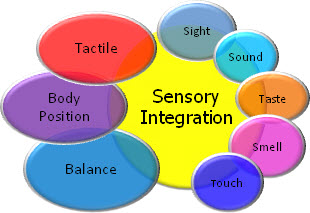Why do children with Autism seem out of touch with their surroundings?
Part of the answer is that they sense things differently than other people. How do we know this? A test has been developed that can tell us how individual children sense things. This test, called the short sensory profile (SSP), is a list of questions answered by children’s caregivers. The results can describe how a child experiences his senses based on how he reacts to certain situations and objects. In a 2007 paper, researchers compared the scores of children with Autism to “normal” scores in order to pinpoint more precisely exactly how individuals with Autism experience of the world differs from others.
What are senses? Senses are how we interact with the world around us. Signals from sensory organs such as the eyes, ears, nose, tongue, and skin are sent to the brain, where the brain then has to make sense of these signals. Even though our surroundings don’t change, they appear different to everyone based on how each individual’s brain interprets the signals it receives from their sensory organs. The SSP is a way to tell how a particular child’s brain interprets the sensory information it receives, and if and how their interpretation differs from “normal.”
What did they find? In terms of total score, 83.6% of the children with autism demonstrated a definite difference in how they experienced their senses. The sections of the test with the highest scores were:
- Underresponsive/seeks sensation: A high score in the underresponsive/seeks sensation category means that the child is not as sensitive as other children, and so they must do everything more than normal in order to feel it. Children like this may seek out sensation by running, spinning, jumping, shaking their head, or doing other activities. Alternatively, a very low score means that the child is more sensitive than other children and does not seek out sensation because they feel normal levels so much more.
- Auditory filtering: This describes a person’s ability to filter through the sound they hear for the important parts, for example speech. A high score here means that the child is unable to tell which sounds are important, like their mother calling their name, and which are not, like traffic noise. As a result, the child pays equal attention to all the sounds he hears.
- Tactile sensitivity: A high score in this category means that the child is exceptionally sensitive to touch. This explains why some autistic children are fascinated by certain textures, for example corduroy or velvet. A very low score means that they do not feel physical sensations as much as normal children.
- Taste and smell sensitivity: A high score in this category means the child is very sensitive to tastes and smells. A very low score means that they taste and smell less than normal children.
What does this mean, overall? These results indicate that children with autism have a flawed ability to sort through sensory information. Because they cannot tell which information is important and which is not, this affects their ability to concentrate, solve problems, and generally participate in daily life. Although much of this was already known or at least guessed at, this study pinpointed specific areas where children with Autism (and likely adults) struggle. This and further research in this area will be important in helping autistic people and their caregivers understand and cope with their condition.
What does this mean for my child with Autism? Even for children without autism, knowing how they experience their senses can be very helpful to parents and healthcare practitioners. For example, if you know that your child does not process information he hears very well, you can adapt how you communicate with him by supplementing your spoken instructions with visual cues such as pictures or gesturing. This will make it easier for him to understand what you’re telling him.
Children with Autism often find it difficult to transition to new environments because they do not react to things the same way typically developing children do. When your child is receiving treatment, whether it be speech therapy, physiotherapy, or any other kind of instruction, the lessons will be more effective if the practitioner understands how your child’s senses work. Knowing how your child experiences senses is also helpful because the practitioner will know what upsets him and what fascinates him, so the treatments can be tailored to his specific needs.
Source: Tomchek, S. D., & Winnie, D. (2007). Sensory processing in children with and without autism: A comparative study using the short sensory profile. The American Journal of Occupational Therapy, 61 (2), 190-200.
Katherine Christ, honours Linguistics, Head of Research at Simone Friedman Speech-Language Services



